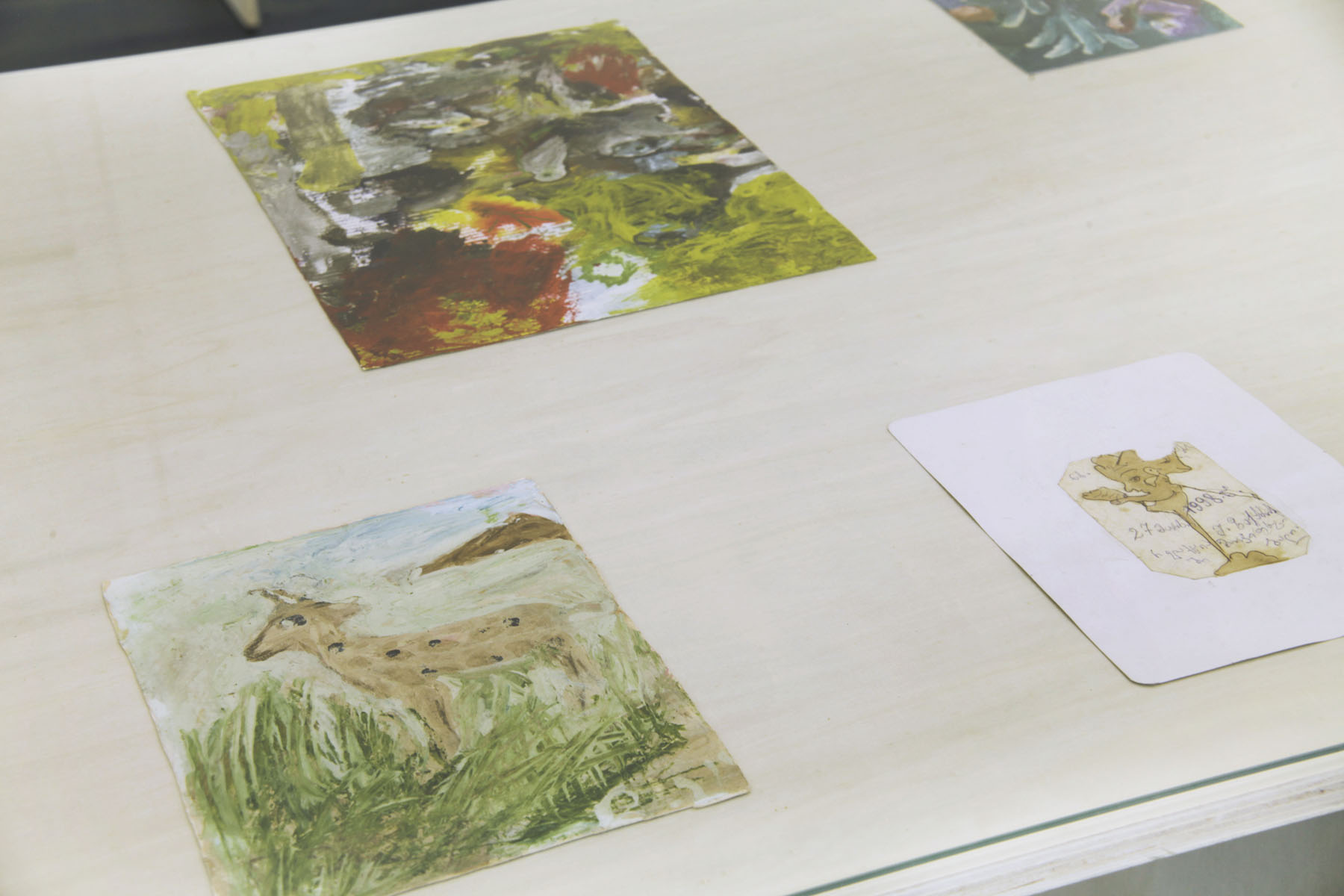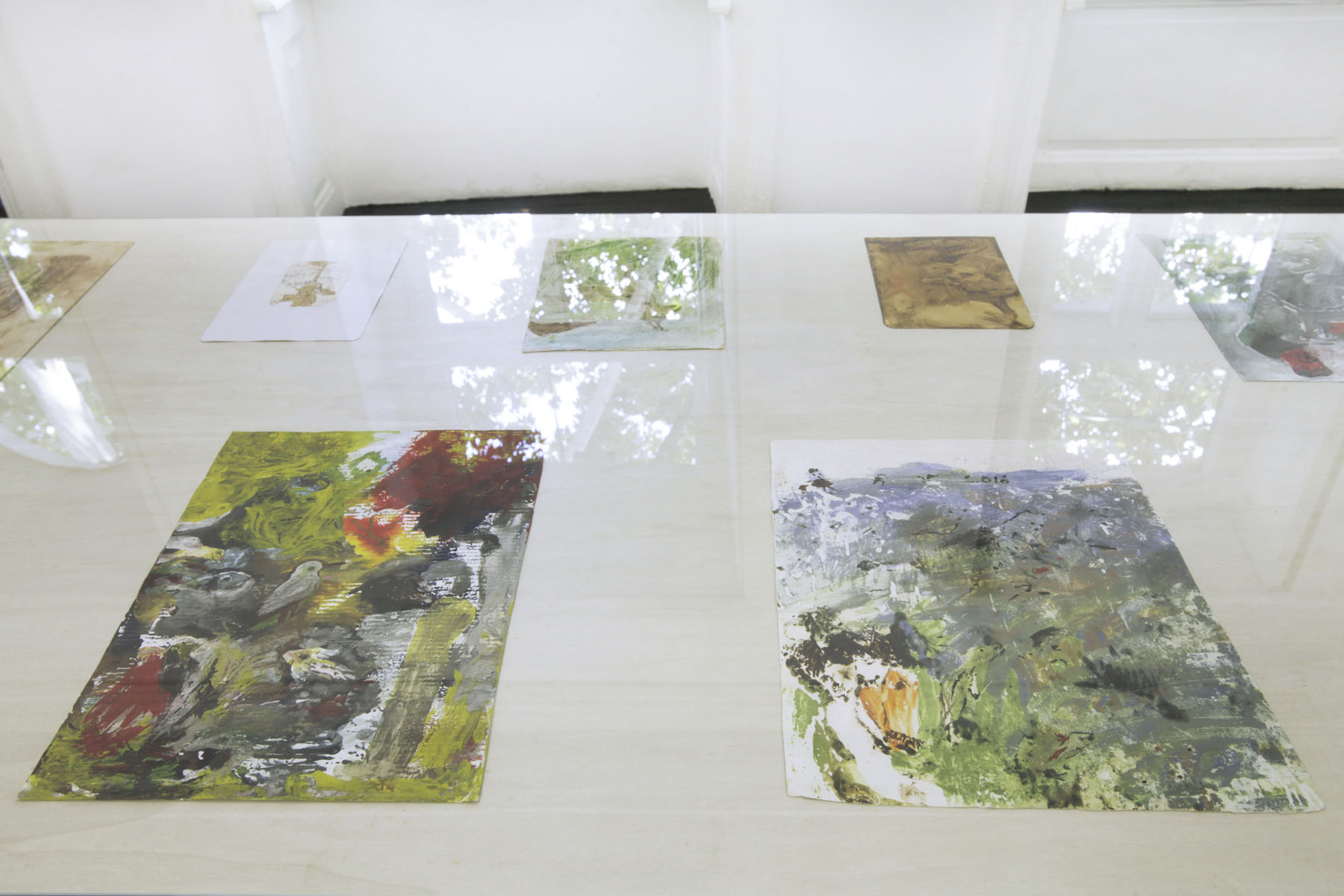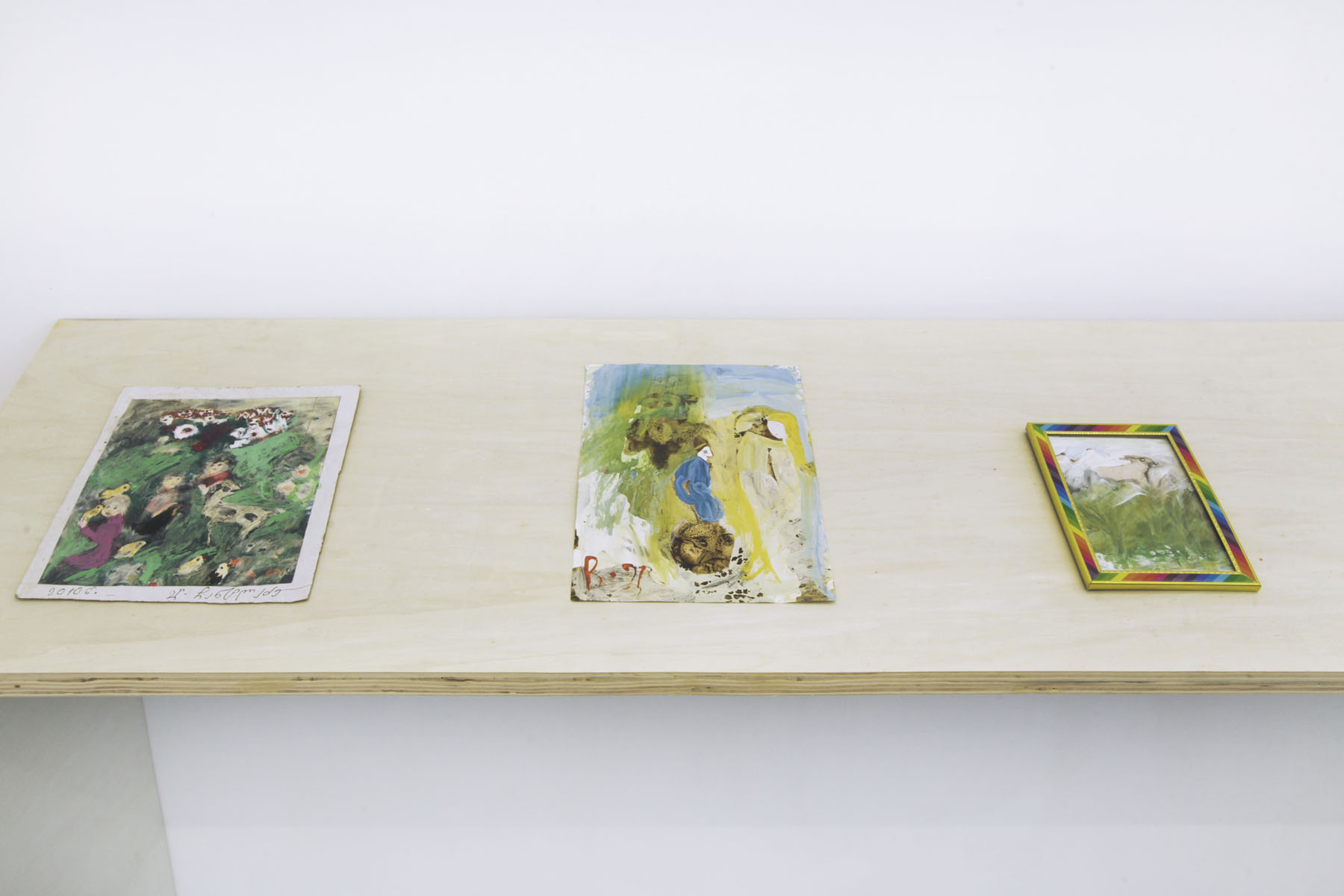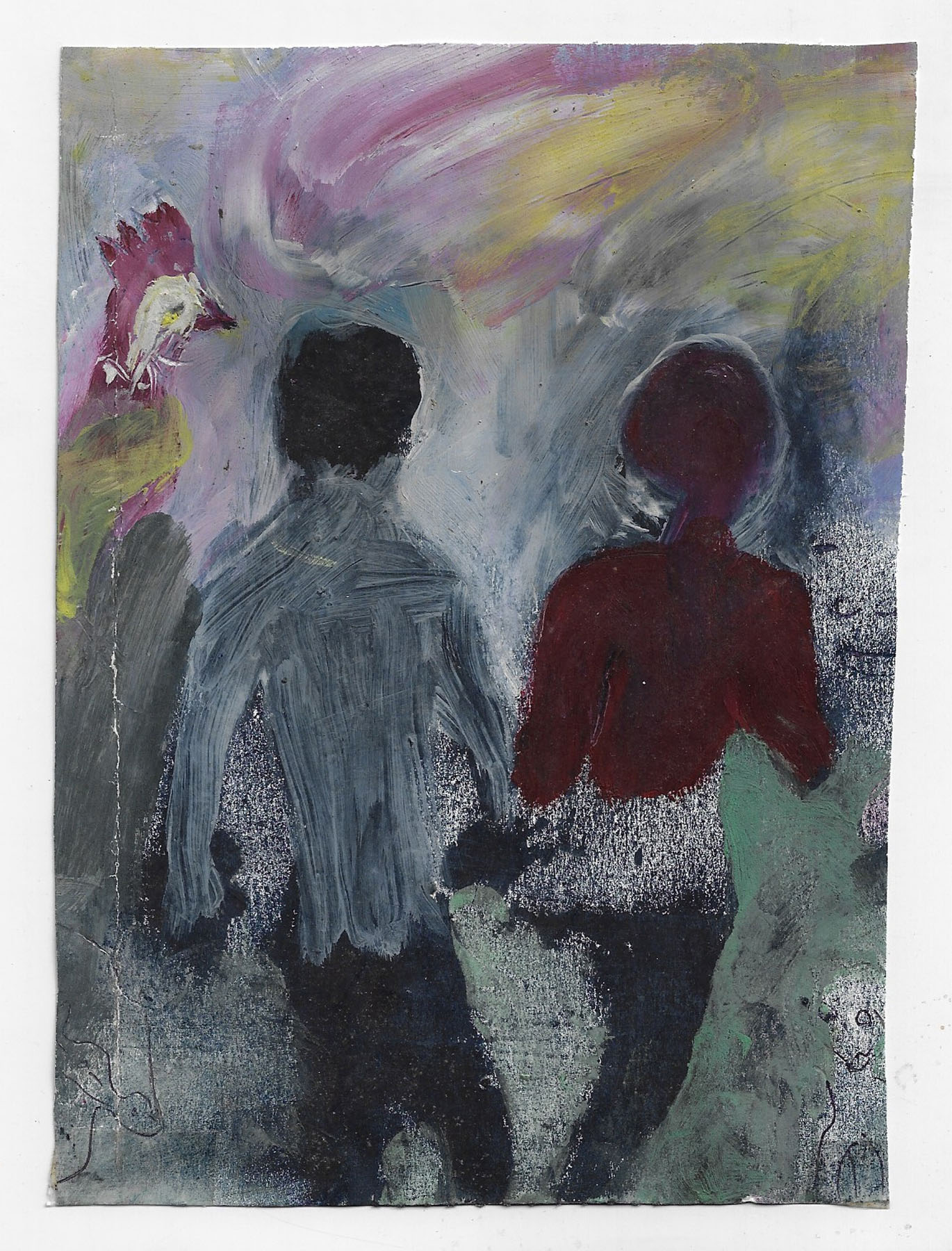Artist: Elene Chantladze
In collaboration with: Gallery Nectar
Venue: LC Queisser, Tbilisi, Georgia
Date: August 12 – October 4, 2020
Photography: all images copyright and courtesy of the artists and LC Queisser
Conversation between Elene Chantladze and Nino Sekhniashvili, 2019 (excerpt)
E: I am seventy-two years old. Since I settled in Tskaltubo, I have been in contact with the public through the library. I had work to do, but I would not leave the library. I was always going there, borrowing books, I was a reader. Events used to take place at Tskaltubo Library #1: Women’s Day, Children’s Day, April 9, everything important that happened in life was commemorated at the library. There was the Society of Writers, Mr. Otia Loseliani, the city administrators and culture workers would visit, and children were singing songs, playing music, performances used to take place. Then there was cake and coffee. Coming home I would tell myself: You were on the peak and now you are somewhere in the abyss.
N: How and about what do you write?
E: I will leave my diary with you and you will understand how I write. I had hard times in life, I had to destroy a big part of my diaries. I was told that instead of burning them, I should have changed my name and saved the writings. But at that moment I was glad that I had burnt them and eliminated some sorrow.
Since the little ones were born, my grandchildren and great-grandchildren, I put their actions into the diary, I draw their fingers, record what they say, I give them small scripts, something that will fit a page or two, really tiny. When I am gone, they will read those and understand who their grandmother was and what kind of a soul she had.
Together with writing, I used to see certain things in stones or in twigs that were washed ashore. People were having fun, jumping in the water, I was looking around, at stones, shells, seeing figures. I was hiding it from others. What would they have thought if they knew I was collecting stones? After bringing them home, I would make pictures on them, sometimes of an animal, sometimes of a person. Even when you just look at stones, after this conversation you will inevitably see things on them. Not an airplane, no stars, nor the moon or the sun, only earthly creatures, humans or animals. You may think you are seeing a cave, I showed you the fish I drew from there, it’s not heavenly. I have collected up to three hundred stones and colored some of them. If you don’t varnish them, the stone will eat the color as the years pass. It’s like children having fun with toys, but I felt something else as well. These are the paths I have been taking. When I turned fifty, I thought about what to do with so many stones, if I die people would make fun of me.
I have been thinking about death since childhood, I cannot get used to the idea that I will pass away. Someone with a similar mind will understand my story about these stones, but who is like that? Maybe there is just one, somewhere? I am in the middle of the city and the other one will be somewhere at the other end… How will I deal with paper? I should abandon stones. I should not let them inside the house.
I used to work at a diagnostic center. Who had a job in the 1990s? They threw us around like a ball, in many directions. It was hard to get bread. In 96, 97, we were two widows, mother and daughter with two kids at home. My daughter was working, and I was bringing up her children for her. I was very close to them, so that since the age of two the boy always cried “grandmother, grandmother” and would not go near his mother. Once his mother beat him and took him to bed so that he would feel his mother’s warmth. She put him next to her and hugged him by force, so that he would get used to her.
In such a hardship they granted me a pension of seven laris. One doctor, who used to attend the literature circle, was also in charge of pensions. He asked how he could help me. I told him that I needed a pension before having reached retirement age, because my legs were hurting. He told me to prepare the documents and then he would grant the pension. So I ended up with a pension of seven lari, but even that would come two, three months late. We survived thanks to my daughter Nino’s work and the garden. We would grow some, corn, vegetable, and lived from that.
Then one of my acquaintances found me a job at the diagnostic center with a salary of twenty laris. I was responsible for taking care of, cleaning and organizing the entire two-story diagnostic center, where surgeries took place. Doctors always used to have chocolate there, which they would share with me. But I was less interested in the chocolates than in their boxes: I painted on them and I cut some out to use as frames. I made four hundred works like that. I never bothered my daughter to buy me a brush or paint: I tried to make colour by pressing saffron and mixing it with oil, but I found the results unpleasant. I also experimented with elderberry juice, jam or wine. Somebody taught me to mix tar with oil or petrol. And I dimmed the surface of some paintings on a kerosene stove. I would not burn firewood, I used to see something in it all the time. This is how I created these works.
N: A text and a painting, are these two separate things for you?
E: I was born by the sea. The Supsa River flowed in front of my house. I would look out of the window of a two-story house, the water was swaying, countless birds were flying over it towards the spring: unnamed geese and swans, birds with tufts. Fish were in the water. They know how to dance, they jumped, they moved towards the shore. If I say that fish are dancing, people will laugh at me and say that I have gone insane. Grandfather’s room with a broken window used to be on this side. I loved climbing up on the old cupboard above the beds. Thinking of grandparents. Swallows would talk above me. Everything used to come to me: like you must take care of your own child, take care of family members, this is how they would follow me. When I had children, I made up a poem about a little bear. I am surprised how I made it, as I have not ever seen a bear cub in a forest [….]
Elene Chantladze (b.1946) lives and works in Tskaltubo. A selection of exhibitions include:
‘Four Discourses’ – exhibition organized by Gallery Nectar in the framework of TAF Tbilisi Art Fair, Tbilisi (2019); ‘Dinosaurs Are Walking in the City’ – solo exhibition, Gallery Nectar, Tbilisi, (2018/19); ‘Diaries’ – Elene Chantladze, public reading in the framework of ‘Performance Days,’ Gallery Nectar, Tbilisi (2018); Connecting Spaces – Klingental, Basel (2014-15); Solo exhibition – Tskaltubo Art Festival, Tskaltubo (2014).
Elene Chantladze, 2020, exhibition view, LC Queisser, Tbilisi
Elene Chantladze, 2020, exhibition view, LC Queisser, Tbilisi
Elene Chantladze, 2020, exhibition view, LC Queisser, Tbilisi
Elene Chantladze, 2020, exhibition view, LC Queisser, Tbilisi
Elene Chantladze, 2020, exhibition view, LC Queisser, Tbilisi
Elene Chantladze, 2020, exhibition view, LC Queisser, Tbilisi
Elene Chantladze, 2020, exhibition view, LC Queisser, Tbilisi
Elene Chantladze, 2020, exhibition view, LC Queisser, Tbilisi
Elene Chantladze, 2020, exhibition view, LC Queisser, Tbilisi
Elene Chantladze, 2020, exhibition view, LC Queisser, Tbilisi
Elene Chantladze, 2020, exhibition view, LC Queisser, Tbilisi
Elene Chantladze, 2020, exhibition view, LC Queisser, Tbilisi
Elene Chantladze, 2020, exhibition view, LC Queisser, Tbilisi
Elene Chantladze, The Year of the Rabbit, 2011, Gouache, pen on paper, 24 × 22 cm (9 1/2 × 8 5/8 inches)
Elene Chantladze, Untitled, 2000, Gouache on cardboard, 33 × 23.5 cm (13 × 9 1/4 inches)
Elene Chantladze, Untitled, Mixed media on cardboard, 13.3 × 28 cm (5 1/4 × 11 inches)
Elene Chantladze, The Stepmother and the Stepchild ( Fairy Tale), Gouache on paper, 28.5 × 21 cm (11 1/4 × 8 1/4 inches)
Elene Chantladze, Untitled, Mixed media on cardboard, 22 × 17.5 cm (8 5/8 × 6 7/8 inches)
Elene Chantladze, Untitled, Mixed media on cardboard, 18.5 × 13 cm (7 1/4 × 5 1/8 inches)
Elene Chantladze, Untitled, 2015, Mixed media on cardboard, 28 × 19 cm (11 × 7 1/2 inches)
Elene Chantladze, Untitled, Gouache, pen on cardboard, 29 × 22 cm (11 3/8 × 8 5/8 inches)
Elene Chantladze, Untitled, Mixed media on paper, 17.8 × 13 cm (7 × 5 1/8 inches)
Elene Chantladze, Untitled, 2016, Gouache on cardboard, 29.8 × 22.7 cm (11 3/4 × 8 7/8 inches)
Elene Chantladze, Untitled, Mixed media on cardboard, 27.5 × 17 cm (10 7/8 × 6 3/4 inches)
Elene Chantladze, Untitled, 2000, Mixed media on cardboard, 23 × 16.5 cm (9 × 6 1/2 inches)
Elene Chantladze, Untitled, 2010, Gouache on paper, 25.8 × 22.8 cm (10 1/8 × 9 inches)
Elene Chantladze, Freestyle Painting, 2019, Mixed media on paper, 29.6 × 21 cm (11 5/8 × 8 1/4 inches)
Elene Chantladze, tbc, 1996, Gouache on cardboard, 25 × 20 cm (9 7/8 × 7 7/8 inches)
Elene Chantladze, tbc, 1998, Mixed media on paper, 20 × 14.3 cm (7 7/8 × 5 5/8 inches)
Elene Chantladze, Meeting, 2003, Mixed media on cardboard, 14.7 × 17.6 cm (5 3/4 × 6 7/8 inches)




































